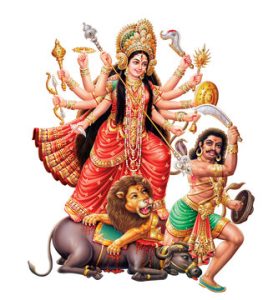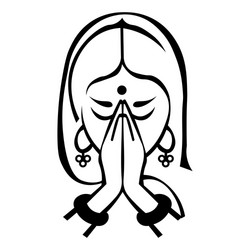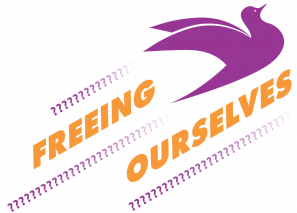In My Meditation Today: I noticed an active, engaged part of me focused entirely on protecting me from failure and its emotional consequences. Her cleverness in ensuring I do not keep my word to myself constantly amazes me. She comes up with the most logical, irrefutable arguments to convince me that promises I made to myself were made foolishly and need not be kept. E.g. this morning, she told me I should not spend more than 20 minutes on meditative writing. She wanted me to stop and return to mindless browsing to stop feeling the fear and anxiety about politics and the new things I am doing – the teleseminar series, the blog, coaching clients, etc.
Today, I decided to ignore her & instead breathed into the place in my body where I felt the discomfort. As I did, it struck me that perhaps the problem was that I had the wrong names for the emotions that I was feeling. What if I named what I felt – “anxiety flavored with joy, excitement, and anticipation” instead of “anxiety tinged with fear and inertia”?
Naming is a powerful act. Almost immediately, there was a small crack in the fear. As I breathed into that crack and focused on joy instead of worry – the lock jam in my brain was released, and I could think again.
Now, back to The Grand Story of the Divine Mother, which is told in three parts. Each part describes a battle between good and evil, and most often, the story is interpreted as the forces of good and bad external to us.
However, a more helpful interpretation is that it represents the battle between my basest instincts and my highest potential.
As we said in the last post, the battles in our myths are bloody and gory because the easiest thing to do is to settle into the space of being okay with our sense of lack, not being enough, the self-hate, and the anger that an unfulfilled life generates. So, a battle to live from your highest potential is hard, ugly, & metaphorically bloody, and gory.
The second section of the Myth – is the story of Mahishasura. He is a demon who is a shapeshifter but mostly presents himself as a raging bull (an uncontrolled ego). When the story starts, he has taken up residence in the heavens and displaced and usurped the authority of Surya, the Sun God, Indra the Rain God, Agni, the Fire God, Vayu the Wind God, Chandra the MoonGod, Varuna the Sea God, and all others.
The displaced demigods approached Brahma, the creative force, and he led them to Vishnu and Shiva to ask for a solution. As the hapless demigods recited their woes to Vishnu and Shiva, their faces contorted in anger, and the radiance of the all-powerful mother within Vishnu & and Shiva formed into Durga, an almighty, powerful Goddess. Armed with weapons from Brahma, Vishnu, Shiva, and the 30 other displaced Gods, she rides into Mahisha’s territory on a lion ( a symbol of Dharma – right action). The sound of the lion’s roar is said to have sent shock waves across the earth and the heavens.
 The Gods rejoice at its sound, but the asuras (demons) who occupy the world now react with resistance and anger and prepare for battle.
The Gods rejoice at its sound, but the asuras (demons) who occupy the world now react with resistance and anger and prepare for battle.
Mahisha himself does not appear in this story. He sends out his army with several high-ranking demons. These demons have very evocative names Chiksura – the inflictor of pain, Chamara -bestial, Mahahanu – coarse, Baksala – bellicosity, hostility, Parivarita – concealed, veiled and Bidala – fetid, impure.
Durga Devi is said to have responded to the hundreds of weapons thrown at her with armaments.
For Durga, this was “Lila” – best translated as joyful play. She knows that everything is a manifestation of herself and has no rancor or anger.
She does destroy the demons, but she is aware that she destroys nothing because as they die, the spirit in all of these demons coalesces and becomes one with her.
The demons are very aware of the separation. They are angry and hostile, coarse and impure, and fighting hard to maintain their separation, for they do not exist without it. Devi intends to kill the demons, and she and her lion kill without guilt or restraint.
The description of the scene of the battle is vivid and shocking.
The narrators do not hold back in describing the war’s goriness or brutality. Devi means business. The demons have no place in her world, and they are annihilated.
Many people ( including me) who read these stories initially like to distance themselves from the violence.
We think of ourselves as peaceful individuals. The mass shooters and terrorists are outside of us – they are beyond our empathy or understanding.
The fact that this is not true was brought home to me vividly recently.
I remember feeling very disappointed about an FB post of a dear friend who posted a political view that opposed mine. I noticed how angry I was at her for dismissing what was so important to me.
The more important point about it was that as I began formulating arguments against her post in my mind, my desire truly was to annihilate her opinion and her sense of well-being. I wanted to swat her like a fly and feel her being defeated in the argument.
Do you recognize that?
Do you realize how violent our intention is when fighting to uphold our viewpoint?
It is because our entire identity is tied to our view, and someone challenging us is akin to them questioning our whole being. So the natural response then is to challenge their being & existence.
That is violence – whether we use a gun or not, it is still the energy of war. It is one we shy away from facing by justifying our anger and disappointment more and more loudly as we feel more and more threatened. Perhaps we are most frightened about the capacity of violence with us. Maybe all the shouting and protesting we do helps us to not face this demon inside us that wants to protect our identity by killing others.
It is the same with every other demon represented in this story – bellicosity, hostility, coarseness, and dishonesty – Notice that these demons have to displace all of nature – the sun, rain, wind, fire, etc., to take control.
A perfect metaphor for the displacing of the higher, wiser, all-knowing self when the bellicosity, hostility, coarseness, and dishonesty take over. Then these ‘demonic forces’ fight hard to maintain the separation between our larger, wiser self and us
What if we recognized those parts of us and separated ourselves from them?
What if we invoked our divinity and looked with compassion at these little-frightened parts of ourselves that project so much violent energy to preserve what they see as their very being?
What if we recognized those parts of us, acknowledged them, allowed for our ability and tendency towards violence, hostility, coarseness, and dishonesty, and still loved ourselves anyway?
Loving ourselves anyway – that is the lesson.
Let me help you learn to love yourself. Click here to schedule a call to chat about everyday exercises to help you build self-love.

